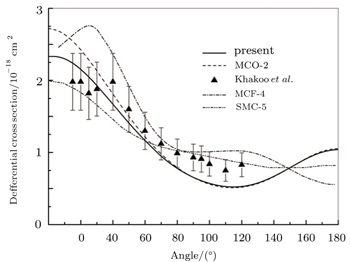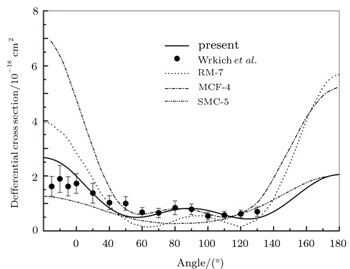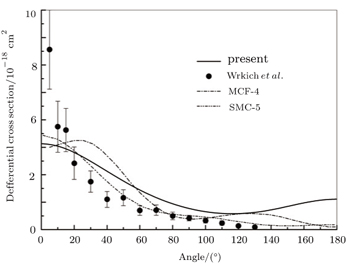† Corresponding author. E-mail:
Project supported by the National Natural Science Foundation of China (Grant Nos. 11447158 and 11404223).
In the present work, the momentum-space multichannel optical method is employed in four-state close-coupling calculations to study the electronic excitation of H2 molecules by electron-impact. Particularly, differential cross sections for the 


Cross sections for the electronic excitation of molecules by electrons impact play an important role in many fundamental areas such as the plasma process, radiation science, astrophysics and planetary atmospheres. Nevertheless, the measurement of reliable cross sections for electronic excitations in molecules remains a difficult challenge for researchers working in this area. Even for the simplest diatomic target, the H2 molecule, the number of experimental measurements is small. Differential cross sections (DCS) for the excited states are measured by Trajmar et al.,[1] Weingartshofer et al.,[2] Hall and Andric,[3] Khakoo et al.,[4] Khakoo and Segura,[5] and Wrkich et al.[6] On the theoretical side, the calculation of accurate cross sections for such processes is also far from satisfactory. Several close-coupling methods are used in the study of excitation in electron-molecule scattering. Two-state calculations for the 
Momentum-space methods are attractive from two points of view. First, differential cross sections are expressed in terms of the initial and final electron momenta so that the amplitudes involved in the calculation are directly related to the experiment. Second, the electron-molecule system has a single center in momentum space, whereas a tractable coordinate-space representation is multi-centered.[17] The momentum-space optical method has been applied to elastic electron scattering from molecules.[18–21] Recently, we developed a multichannel version of this method, and applied it to the calculations of the cross section for excitation in H2 at the two-state close-coupling level of approximation.[12] Our momentum-space multichannel optical method (MCO) computational code has now been extended to also account for multichannel interaction among excited states.
The long-range dipole coupling between states of the same spin is stronger than coupling between the singlet and the triplet. It is essential to include dipole coupling in the excited states manifold in order to achieve meaningful excitation cross sections for excitation from the ground state. We have performed calculations on excitation of the first three triplet excited states of 



The unobserved channels have an effect on the observed channels. Real excitation of the unobserved channels is known as absorption. It removes flux from the observed channels. Virtual excitation of the unobserved channels is referred to as polarization of the target. In this study, a complex, equivalent-local and ab initio optical potential is used to treat the polarization effect and absorption by ionization continuum. The polarization potential contributes significantly to the scattering problem, particularly for forward scattering at intermediate energies.
In this paper, we report differential cross sections for the electron impact excitation of H2 molecules. Our study includes the 


The momentum-space multichannel optical method is a multichannel version of the original momentum-space optical method.[18] Details of the formulation have been given elsewhere,[12,17] and here we will only present the basic aspects of the theory.
The T-matrix element for scattering from the initial channel |0

The space of target states has been split into two parts. The P-space consists of a finite discrete set of channels. The Q-space is the continuum. The complex polarization potential element is written as


We make the following partial-wave expansion of the potential matrix elements.


It is a set of coupled integral equations, which is solved by matrix inversion after representing the q integration by a quadrature rule.[17]
In practice as L increases the off-diagonal potential matrix elements decrease and become negligible after a value L0. For L ≤ L0 the corresponding set of coupled equations is solved fully. For L > L0 the potential is essentially spherical and uncoupled integral equations are solved for each L.
The molecular orbital ψj is represented by a linear combination of atomic orbitals centered at the nuclear sites

For target molecules in the gas phase, we assume random initial orientations and treat rotational excitation as an adiabatic process. This is equivalent to averaging the differential cross section over molecular orientations. Following the work of Gallup,[22] we transform our entrance and exit channel momenta

The differential cross section is

Our calculations are performed within the framework of fixed-nuclei and Frank-Condon approximations at the equilibrium internuclear distance of 1.4 a0. The wave functions of the target states 





The differential cross section is the most sensitive test for theoretical models. The results for electronic excitation out of ground state into the higher levels at incident energies of 20 eV and 30 eV are shown in Figs.
 | Fig. 1. Differential cross section for excitation of the  |
 | Fig. 2. Differential cross section for excitation of the  |
 | Fig. 3. Differential cross section for excitation of the  |
 | Fig. 4. Differential cross section for excitation of the  |
 | Fig. 5. Differential cross section for excitation of the c3Πu state of H2 at the incident energy 20 eV. Theoretical work: Full curve, present; Dot, RM-7;[14] Dash dot, MCF-4;[15] Dash–dot dot, SMC-5.[16] Experimental: bullet, Wrkich et al.[6] |
 | Fig. 6. Differential cross section for excitation of the c3Πu state of H2 at the incident energy 30 eV. Theoretical work: Full curve, present; Dash dot, MCF-4;[15] Dash–dot dot, SMC-5.[16] Experimental: bullet, Wrkich et al.[6] |
Figures 
In Figs. 
Differential cross sections for the 
In this paper, we have presented an application of the multichannel optical method in the study of the electronic excitation of H2 molecules by electron impact. DCSs for transitions leading to the lowest three triplet states of the target are calculated in a four-state level of close-coupling approximation. The discrepancy between the present MCO-4 results and previous MCO-2 results reveals the importance of the inclusion of multichannel effects in the calculation. The agreement between our results and experimental measurements is encouraging. We are interested in applying the MCO method to studies of electron collisions with larger molecules.


